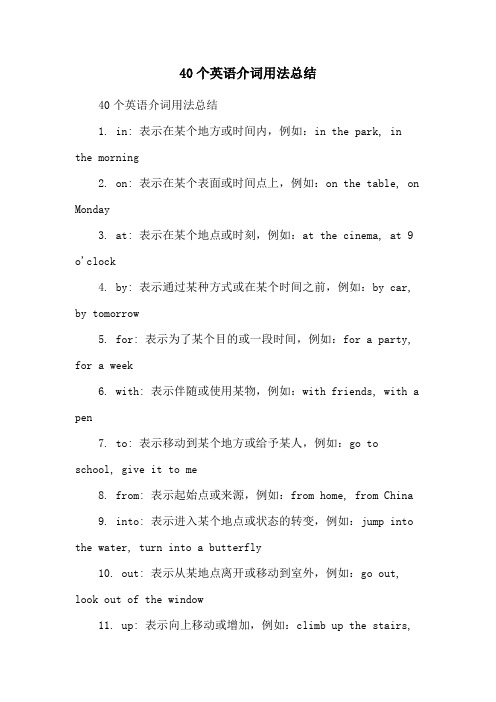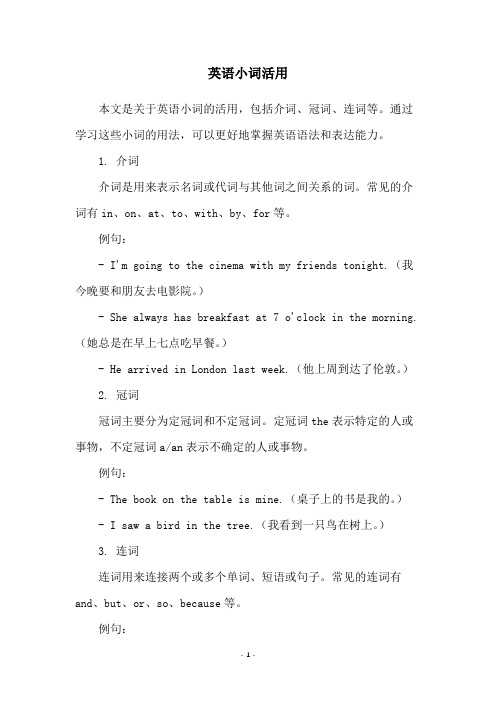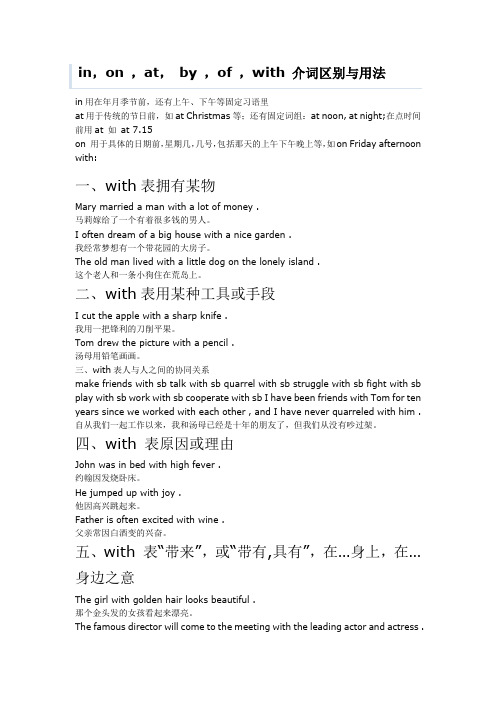介词in,on.at,for.with,by,of的基本用法
40个英语介词用法总结

40个英语介词用法总结40个英语介词用法总结1. in: 表示在某个地方或时间内,例如:in the park, in the morning2. on: 表示在某个表面或时间点上,例如:on the table, on Monday3. at: 表示在某个地点或时刻,例如:at the cinema, at 9 o'clock4. by: 表示通过某种方式或在某个时间之前,例如:by car, by tomorrow5. for: 表示为了某个目的或一段时间,例如:for a party, for a week6. with: 表示伴随或使用某物,例如:with friends, with a pen7. to: 表示移动到某个地方或给予某人,例如:go to school, give it to me8. from: 表示起始点或来源,例如:from home, from China9. into: 表示进入某个地点或状态的转变,例如:jump into the water, turn into a butterfly10. out: 表示从某地点离开或移动到室外,例如:go out, look out of the window11. up: 表示向上移动或增加,例如:climb up the stairs,wake up12. down: 表示向下移动或减少,例如:walk down the hill, calm down13. about: 表示关于某事或在某个范围内,例如:talk about the movie, wander about the city14. off: 表示离开或关闭,例如:get off the bus, turnoff the lights15. on: 表示打开或激活,例如:turn on the TV, switch on the computer16. over: 表示越过或在某地上方,例如:jump over the fence, fly over the city17. under: 表示在某物下面或被控制或影响,例如:hide under the bed, live under his rules18. with: 表示具有某种特征或和某人一起做某事,例如:a man with blue eyes, dance with me19. without: 表示没有某物或在缺乏某物的情况下,例如:go without food, live without regret20. by: 表示通过某种方式,例如:learn by doing, go by bus21. through: 表示穿过某物或完成某事,例如:walk through the door, go through the documents22. across: 表示横穿某物或在某个范围内,例如:swimacross the river, all across the world23. between: 表示在两个事物之间或在某个时间段,例如:choose between two options, between 9 and 10 o'clock24. among: 表示在三个或三个以上事物之间或在某群人中,例如:share among friends, discuss among colleagues25. around: 表示在周围或在某个时间点附近,例如:walk around the park, around midnight26. through: 表示通过某事物或在某段时间内,例如:read through the book, work through the night27. against: 表示反对或靠在某物上,例如:fight against injustice, lean against the wall28. for: 表示代表或支持某人或某事,例如:vote for a candidate, fight for freedom29. towards: 表示朝向某个方向或对某人有好感,例如:walk towards the beach, feel towards someone30. within: 表示在某个时间或范围内,例如:arrive within an hour, within the city limits31. beyond: 表示超出某个界限或超过某个程度,例如:beyond expectations, beyond the horizon32. along: 表示沿着某个路线或伴随某人一起,例如:walk along the street, sing along with the song33. above: 表示在某物之上或高于某个程度,例如:flyabove the clouds, above average34. below: 表示在某物之下或低于某个程度,例如:swim below the surface, below freezing35. beside: 表示在某物旁边或和某人一起,例如:sit beside me, beside the lake36. near: 表示在某物附近或接近某个时间,例如:live near the beach, near the end37. past: 表示经过某个地点或在某个时间之后,例如:walk past the store, past midnight38. around: 表示在周围或大约某个数量,例如:look around the room, around 20 people39. after: 表示在某个时间之后或追求某人或某事,例如:after dinner, run after the dog40. before: 表示在某个时间之前或在某个事件之前,例如:before sunrise, before the meeting这些介词是英语中常用的一些基本介词,它们在表达地点、时间、方式等方面起到了重要的作用。
常用介词基本用法辨析

常用介词基本用法辨析我们在阅读理解和完形填空中,常常会看到一些要求我们对介词基本含义的理解,对于能否正确理解文意,起着十分重要的作用!下面,小编在这给大家带来常用介词基本用法辨析,欢迎大家借鉴参考!常用介词基本用法辨析表示方位的介词:in, to, on1. in 表示在某地范围之内。
Shanghai is/lies in the east of China. 上海在中国的东部。
2. to 表示在某地范围之外。
Japan is/lies to the east of China. 日本位于中国的东面。
3. on 表示与某地相邻或接壤。
Mongolia is/lies on the north of China. 蒙古国位于中国北边。
表示计量的介词:at, for, by1. at 表示“以……速度”“以……价格”。
It flies at about 900 kilometers an hour. 它以每小时900公里的速度飞行。
I sold my car at a high price. 我以高价出售了我的汽车。
2. for 表示“用……交换,以……为代价”。
He sold his car for 500 dollars. 他以五百元把车卖了。
注意:at表示单价(price) ,for表示总钱数。
3. by 表示“以……计”,后跟度量单位。
They paid him by the month. 他们按月给他计酬。
Here eggs are sold by weight. 在这里鸡蛋是按重量卖的。
表示材料的介词:of, from, in1. of 成品仍可看出原料。
This box is made of paper. 这个盒子是纸做的。
2. from 成品已看不出原料。
Wine is made from grapes. 葡萄酒是葡萄酿成的。
3. in 表示用某种材料或语言。
Please fill in the form in pencil first. 请先用铅笔填写这个表格。
英语小词活用

英语小词活用本文是关于英语小词的活用,包括介词、冠词、连词等。
通过学习这些小词的用法,可以更好地掌握英语语法和表达能力。
1. 介词介词是用来表示名词或代词与其他词之间关系的词。
常见的介词有in、on、at、to、with、by、for等。
例句:- I'm going to the cinema with my friends tonight.(我今晚要和朋友去电影院。
)- She always has breakfast at 7 o'clock in the morning.(她总是在早上七点吃早餐。
)- He arrived in London last week.(他上周到达了伦敦。
) 2. 冠词冠词主要分为定冠词和不定冠词。
定冠词the表示特定的人或事物,不定冠词a/an表示不确定的人或事物。
例句:- The book on the table is mine.(桌子上的书是我的。
) - I saw a bird in the tree.(我看到一只鸟在树上。
)3. 连词连词用来连接两个或多个单词、短语或句子。
常见的连词有and、but、or、so、because等。
例句:- I like coffee and tea.(我喜欢咖啡和茶。
)- She is smart but sometimes lazy.(她很聪明,但有时懒惰。
)- Would you like pizza or pasta for dinner?(晚餐你想吃比萨还是意大利面?)以上是英语小词的部分活用,希望能对大家的英语学习有所帮助。
in,on ,at, by ,of ,with 介词区别与用法

in,on ,at,by ,of ,with 介词区别与用法in用在年月季节前,还有上午、下午等固定习语里at用于传统的节日前,如at Christmas等;还有固定词组:at noon, at night;在点时间前用at 如at 7.15on 用于具体的日期前,星期几,几号,包括那天的上午下午晚上等,如on Friday afternoon with:一、with表拥有某物Mary married a man with a lot of money .马莉嫁给了一个有着很多钱的男人。
I often dream of a big house with a nice garden .我经常梦想有一个带花园的大房子。
The old man lived with a little dog on the lonely island .这个老人和一条小狗住在荒岛上。
二、with表用某种工具或手段I cut the apple with a sharp knife .我用一把锋利的刀削平果。
Tom drew the picture with a pencil .汤母用铅笔画画。
三、with表人与人之间的协同关系make friends with sb talk with sb quarrel with sb struggle with sb fight with sb play with sb work with sb cooperate with sb I have been friends with Tom for ten years since we worked with each other , and I have never quarreled with him . 自从我们一起工作以来,我和汤母已经是十年的朋友了,但我们从没有吵过架。
四、with 表原因或理由John was in bed with high fever .约翰因发烧卧床。
英语介词用法口诀大全

英语介词用法口诀大全
1. In, on, at 常与时间连,时间地点兼备用。
2. From, to, until, till 时间区间好表示,时间段也可大显神通。
3. By, with, from, of 用于表现方式,类别性介词很不错。
4. Of, for, to 用于表目的,句子结构会媲美。
5. About, with, by 用于表同伴,主谓间隔并不遥远。
6. To, with, without 用于表伴随,进行中卖力才是王道。
7. In, to, on, at 用于表示空间,位置与方向齐心助阵。
8. From, between, among 分别表起点、间隔和混杂,还可表格局不一并掌握。
9. Of, in, about 用于表品质,为句子增色不在话下。
10. About, on, with 用于表主题,内容丰富不含糊。
11. In, on, at 用于表时刻,具体程度可考虑。
12. By, of, with 用于表方式,越具体越考验。
介词在句子中的作用和用法

介词在句子中的作用和用法介词是语法中一个重要的词类,用来表示人或物之间的关系。
它常常出现在句子中,起到连接句子成分、状语的作用。
介词通常位于名词或代词之前,用来修饰这些词的意义。
介词的用法有很多种,以下将介绍一些常见的用法和注意事项。
1. 表示关系介词可以表达时间、空间、方向、原因、目的、条件等关系。
常见的介词有:in、on、at、by、with、for、to等。
(1)时间关系:介词in用于表示在某个时间段内,如in the morning(在早上),in summer(在夏天);介词on用于表示具体某天或某一天的上午、下午等,如on Sunday(在星期天),on Monday afternoon(在星期一下午)。
(2)空间关系:介词in用于表示在某个空间范围内,如in the room(在房间里);介词on用于表示在某个平面或表面上,如on the table(在桌子上);介词at用于表示在某个点或地方,如at the bus stop(在公交车站)。
(3)方向关系:介词to用于表示朝向某个地方,如go to school (去学校);介词from用于表示来自某个地方,如come from Beijing (来自北京)。
(4)原因关系:介词for用于表示某个行为或状态的原因,如thank you for your help(谢谢你的帮助)。
(5)目的关系:介词for用于表示为了某个目的,如study hard for success(为了成功而努力学习)。
(6)条件关系:介词if用于表示条件,如if it rains(如果下雨)。
2. 合并句子介词可以用来合并两个句子,使句子更连贯。
常见的介词有:and、but、or等。
(1)and用于表示并列关系,连接两个相似的句子,如I like toread books and watch movies(我喜欢读书和看电影)。
(2)but用于表示转折关系,连接两个相反的句子,如She is smart but lazy(她聪明但懒惰)。
五年级英语总结-介词

介词介词是英语中最活跃的词类之一。
它们的搭配能力很强,与其它词组合,表达不同的意思。
几乎所有的地点或时间前,都会用到介词。
小学的介词已学的有以下十几个。
in,on,under,by,beside,at,for,with,to,about,from,before,after,in front of,behind一、常见搭配1. 动词+介词listen to(听……)laugh at(笑……)look at(看……)get to(到达……)write to(给某人写信)knock at(敲……)say goodbye to(向…道别)be(am,is,are)from来自=come from play with(和……玩耍)go (come)with(和……去,来)go to(去)take a train to(乘火车到……)give…to(把……给……)share with(和……分享)send…to(把……送给……)say to(对……说)talk with(和……谈论)live in(住在)say hello to(和……打招呼)fill…with(用……填满)thank…for(为……表示感谢)wait for(等待)2. 形容词+介词be(am,is,are)good at+名词(或动词+ing)擅长做某事be(am,is,are)far from离……远3. 介词+名词或名词+介词lots of = a lot of(许多)It’s time for +名词(该……的时候了)by my clock(按照我的表) a ticket to…(一张到……的票)by the way(顺便问一下)on the way(在路上)the way to…(到……的路)on TV(the telephone)在电视上(通过电话)by bike(骑自行车)on foot(步行) a glass of一杯……two glasses of两杯……about 7:00(大约7点)two kilos of(两千克……) the sound of music(音乐之声)for a long time(很久)at once(马上)4. 特殊疑问词+介词What(How)about+名词(或动词+ing)……怎么样?二、各种介词的用法1. in①用于大时间,大地点in summer在夏天in a week(一周内)in a month一月内in a year一年内in Kaifeng在开封in China 在中国in the street在街上②在……里面in a box在盒子里③泛指早上、下午、晚上in the morning(afternoon,evening)在早上、下午、晚上④穿……颜色的衣服in red(blue,yellow)穿着红(蓝、黄)衣服2. on①在……上面on the wall在墙上on the farm在农场②用于具体某天或某天的某段时间on Monday在周一on Monday morning在周一早上on weekend在周末③通过某种媒介on TV在电视上on the telephone通过电话3. at①用于某一时间点at 7:00在七点at the age of 6.在六岁的时候。
介词常见11个用法归纳

介词1.介词的含义,介词(虚词),不能在句子中独立充当成分。
它总是用于名词、代词、或相当于名词的其它词类或短语活从句前。
中考需要掌握的11个介词:in、on、at、to、from、by、with、for、about、after、before表示时间的介词A.典型例题:1.in 1996 / in 2002 / in 1847(年份)2.in October / in February / in March (月份)3.in spring / in summer / in autumn / in winter (季节)4.in a week / in a year 在1周/ 年中5.in the morning / in the afternoon / in the evening 在上午/ 下午/ 晚上in those days 在当时/ in no time 立刻/ in the daytime 在白天/ in the future 在将来/ in one minute 在1分钟内/ 最后in the end表示较长时间(长于一天或短于一天)如:年、年份、月份、季节、周、上午、下午、晚上以及一些习惯用法中要用介词“in”。
-------------------------------------------------------------------------------------------------------------------------------- B.典型例题:1.at ten o’clock / at seven thirty. (表示某一钟点)2.at noon / at night / at midnight (在中午、晚上、半夜――一天中相对短暂的时间)3.at the age of twenty / at the age of thirty-five (表示某一年龄)4.at that time 在那时/ at the moment 这时、那时、此刻/ at first 首先/ at last 最后=in the end/ at once 立刻、马上/ at / on (the) weekends 在周末/ 在一年中的这个时候at this time of year / 在……开始/结束时at the beginning /end of表示时间的某一点(或表示某时刻)如:钟点、年龄或其它的习惯用法中要用“at”。
- 1、下载文档前请自行甄别文档内容的完整性,平台不提供额外的编辑、内容补充、找答案等附加服务。
- 2、"仅部分预览"的文档,不可在线预览部分如存在完整性等问题,可反馈申请退款(可完整预览的文档不适用该条件!)。
- 3、如文档侵犯您的权益,请联系客服反馈,我们会尽快为您处理(人工客服工作时间:9:00-18:30)。
介词用法知多少介词是英语中最活跃的词类之一。
同一个汉语词汇在英语中可译成不同的英语介词。
例如汉语中的“用”可译成:(1)用英语(in English);(2)用小刀(with a knife);(3)用手工(by hand);(4)用墨水(in ink)等。
所以,千万不要以为记住介词的一两种意思就掌握了这个介词的用法,其实介词的用法非常广泛,搭配能力很强,越是常用的介词,其含义越多。
下面就简单介绍几组近义介词的用法及其搭配方法。
一. in, to, on和off在方位名词前的区别1. in表示A地在B地范围之内。
如:Taiwan is in the southeast of China.2. to表示A地在B地范围之外,即二者之间有距离间隔。
如:Japan lies to the east of China.3. on表示A地与B地接壤、毗邻。
如:North Korea is on the east of China.4. off表示“离……一些距离或离……不远的海上”。
如:They arrived at a house off the main road.New Zealand lies off the eastern coast of Australia.二. at, in, on, by和through在表示时间上的区别1. at指时间表示:(1)时间的一点、时刻等。
如:They came home at sunrise (at noon, at midnight, at ten o’clock, at daybreak, at dawn).(2)较短暂的一段时间。
可指某个节日或被认为是一年中标志大事的日子。
如:He went home at Christmas (at New Year, at the Spring Festival, at night).2. in指时间表示:(1)在某个较长的时间(如世纪、朝代、年、月、季节以及泛指的上午、下午或傍晚等)内。
如:in 2004, in March, in spring, in the morning, in the evening, etc(2)在一段时间之后。
一般情况下,用于将来时,谓语动词为瞬间动词,意为“在……以后”。
如:He will arrive in two hours.谓语动词为延续性动词时,in意为“在……以内”。
如:These products will be produced in a month.注意:after用于将来时间也指一段时间之后,但其后的时间是“一点”,而不是“一段”。
如:He will arrive after two o’clock.3. on指时间表示:(1)具体的时日和一个特定的时间,如某日、某节日、星期几等。
如:On Christmas Day(On May 4th), there will be a celebration.(2)在某个特定的早晨、下午或晚上。
如:He arrived at 10 o’clock on the night of the 5th.(3)准时,按时。
如:If the train should be on time, I should reach home before dark.4. by指时间表示:(1)不迟于,在(某时)前。
如:He will come by six o’clock.Jack had made some friends by the time you came.(2)在……间,在……的时候。
如:He worked by day and slept by night.5. through指时间意为“从……开始到结束”,此时与throughout相同。
如:We work hard all through the year.三. near, by, beside, at表示“在……附近”时的区别1. near表示相对的近,实际距离可能还很远。
如:Suzhou is near Shanghai.2. by和beside都表示靠近,实际距离不可能很远,但beside比by更具体地表示出“在……旁边”的意思。
如:He was sitting beside her.3. at也有“在旁边”的意思,但多表示有目的的行为所处的位置,而by和beside 仅表示位置关系。
如:The students are sitting at the desks listening to the teacher.Several students are sitting by / beside the window talking about a film.四. at, in和on表示地点时的区别1. at表示地点:(1)用于指较小的地方。
如:I shall wait for you at the station.(2)用于门牌号码前。
如:He lives at 115 Zhongshan Road.2. in表示地点:(1)用于指较大的地方。
如:He lives in Shanghai.(2)虽然是很小的地方,如果说话人住在那里,也可用in。
商店、学校、机关等,若看作一个地点(point)用at,若看作一个场所(place)用in。
如:I met him at the post-office.I’m now working in the post-office.3. on表示地点,一般指与面或线接触,意为“在……上;在……旁”。
如:The picture was hanging on the wall.New York is on the Hudson River.五. besides, except, except for, but表示“除……外”之间的区别1. besides表示“除了……以外,还有……”,具有附加性质。
如:Besides Mr Wang, we also went to see the film.(王先生也去了)注意:besides用于否定句中时,与except, but同义,可互换。
如:We have no other books besides / except these.2. except表示“……除外”,具有排它性质。
如:We all went to see the film except Mr Wang.(王先生没去)3. except for表示“除了……”,即表示除去整体中的一部分。
如:The composition is very good except for a few spelling mistakes.4. but意为“除了”,与except同义,except强调被排除的部分,but则强调整句的内容,常修饰否定意义的代词。
如:Nobody knew it but me.时间介词in, on与at的用法介词in, on与at都可用于表示时间的名词前,但用法各不相同,其区别在于:一、用in的场合(1)表示“在某年/月/季节”这个含义时,须用介词in。
例如:She came to this city in 1980.他于1980年来到这个城市。
It often rains here in summer.夏天这里常常下雨。
(2)表示“从现在起一段时间以后”时,须用介词in。
例如:They will go to see you in a week.他们将在一周后去看望你。
I will be back in a month.我将在一个月后回来。
(3)表示“在某世纪”时,须用介词in.例如:This machine was invented in the eighteenth century.这台机器是在18世纪发明的.Great changes took place in the twentieth 世纪发生了巨大变化.(4)表示“在某年代或特定世纪某年代”时,须用介词in。
例如:This incident happened in the 1970''''s.该事件发生在20世纪70年代。
The Anti-Japanese War broke out in the 1930''''s.抗日战争爆发于20世纪30年代。
除此之外,morning / evening / afternoon 三个词也常跟介词in连用。
例如:Don't watch TV too much in the evening.晚上看电视不要太多。
They sometimes play games in the afternoon.他们有时在下午做游戏。
二、用on的场合(1)表示“在具体的某一天”或“(在具体的某一天的)早上、中午、晚上”等,须用介词on。
例如:Jack was born on May 10th,1982.杰克生于1982年5月10日。
They left on a rainy morning.他们是在一个雨天的早上离开的。
He went back to America on a summer afternoon.他于一个夏天的下午返回了美国。
(2)表示“在星期几”或“在星期几的早上、中午、晚上”等,须用介词on。
例如:We don't go to school on Saturday and Sunday.我们星期六和星期天不上学。
What time do you get up on weekdays你在平日什么时候起床I heard this story on Saturday morning.我是在星期六的早晨听到这个故事的。
(3)表示“在某一节日”时,须用介词on。
例如:We usually eat moon cakes on Mid-autumn Festival.我们通常在中秋节吃月饼。
Mr Hu received a card on Teachers' Day.胡老师在教师节那天收到了一张卡片。
注意:当morning, evening, afternoon被of短语修饰,习惯上用in,而不用on.例如:in the early morning of September 10th 在9月10的清晨;in the late afternoon of September 12th 在9月12日的傍晚。
三、用at的场合(1)表示“某一具体时刻(即几点几分时)”,须用介词at。
例如:He gets up at six o'clock every day .他每天六点起床。
